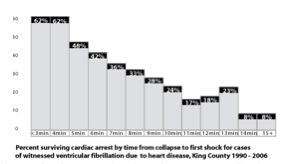SUDDEN CARDIAC ARREST [SCA]
In the US, cardiac arrest affects about 326,200 people annually, yet the average survival rate has maintained around 8.3% for several decades.1 In an effort to enhance survival rates, the CMRETAC has received state funds to develop and implement a regional sudden cardiac arrest survival program.
WHY THESE ELEMENTS ARE IMPORTANT

Cardiac Arrest Registry: Implementing a cardiac arrest registry provides a standardized tool for data collection. Without collecting data, there is no way to measure the effectiveness of system and therefore, no way to guide improvement or enhance overall survival.
Increasing AED access and maintaining a current AED registry that provides Emergency Medical Dispatchers with AED locations, will increase the likelihood of timely defibrillation prior to EMS arrival.

Eisenberg, M.S. (2015). Resuscitate! Seattle, Washington: University of Washington Press.
CPR Instruction and Community Outreach: Increasing awareness and recognition of a cardiac arrest event can greatly improve the likelihood of timely CPR administration. The amount of time that passes between the arrest and the initiation of CPR is one of the strongest predictors of survival. Bystander CPR doubles the probability of cardiac arrest survival.2

University of Arizona Sarver Heart Center CPR Research Group Circulation 1993;88: 1907-1915

Emergency Medical Service Dispatch Cardiopulmonary Resuscitation Prearrival Instructions to Improve Survival From Out-of-Hospital Cardiac Arrest: A Scientific Statement From the American Heart Association. Circulation,125(4), 648-655
Emergency Medical Dispatch Training: A well-developed telephone CPR program can increase bystander CPR by 50%.2 Given the ubiquity of Emergency Medical Dispatchers in the emergency medical response system, training a few hundred Emergency Medical Dispatchers can have a far-reaching effect for several thousands of people. Emergency Medical Dispatch training can increase timely recognition of a cardiac arrest, prompt bystanders on how to respond appropriately, and provide effective CPR instruction before EMS arrival.
NEXT STEPS
We’re very enthusiastic to work with EMS agencies, hospitals, existing programs and organizations and members of the community to implement this program. For additional information, please contact Verena Oberlohr our Chief Sudden Cardiac Arrest Specialist at verena.oberlohr@cmretac.org .
References:
-
Mozaffarian D, Benjamin EJ, Go AS, Arnett DK, Blaha MJ, Cushman M,de Ferranti S, Després JP, Fullerton HJ, Howard VJ, Huffman MD, Judd SE, Kissela BM, Lackland DT, Lichtman JH, Lisabeth LD, Liu S, Mackey RH, Matchar DB, McGuire DK, Mohler ER 3rd, Moy CS, Muntner P, Mussolino ME, Nasir K, Neumar RW, Nichol G, Palaniappan L, Pandey DK, Reeves MJ, Rodriguez CJ, Sorlie PD, Stein J, Towfighi A, Turan TN, Virani SS, Willey JZ, Woo D, Yeh RW, Turner MB; on behalf of the American Heart Association Statistics Committee and Stroke Statistics Subcommittee. Heart disease and stroke statistics–2015 update: a report from the American Heart Association. Circulation. 2015;131:e29–e322.doi: 10.1161/CIR.0000000000000152.
-
Eisenberg, M.S. (2015). Resuscitate! Seattle, Washington: University of Washington Press.
-
Lerner, E. B., Rea, T. D., Bobrow, B. J., Acker, J. E., Berg, R. A., Brooks, S. C., . . . Travers, A. H. (2012). Emergency Medical Service Dispatch Cardiopulmonary Resuscitation Prearrival Instructions to Improve Survival From Out-of-Hospital Cardiac Arrest: A Scientific Statement From the American Heart Association. Circulation,125(4), 648-655. doi:10.1161/cir.0b013e31823ee5fc
-
Hebel, G. A. (1994). Bystander cardiopulmonary resuscitation: Is ventilation necessary? The Journal of Emergency Medicine,12(3), 416. doi:10.1016/0736-4679(94)90293-3
